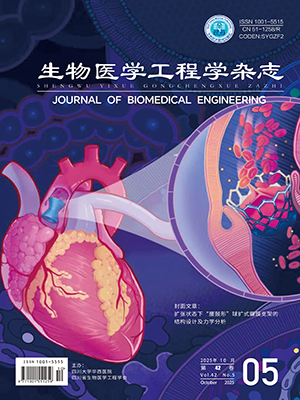| 1. |
Caceres J A, Goldstein J N. Intracranial hemorrhage. Emergency Medicine Clinics of North America, 2012, 30(3): 771-794.
|
| 2. |
Hemphill J C 3rd, Greenberg S M, Anderson C S, et al. Guidelines for the management of spontaneous intracerebral hemorrhage: a guideline for healthcare professionals from the American Heart Association/American Stroke Association. Stroke, 2015, 46(7): 2032-2060.
|
| 3. |
Vitt J R, Sun C H, Le Roux P D, et al. Minimally invasive surgery for intracerebral hemorrhage. Current Opinion in Critical Care, 2020, 26(2): 129-136.
|
| 4. |
Liao C C, Chiang I J, Xiao F, et al. Tracing the deformed midline on brain CT. Biomedical Engineering: Applications, Basis and Communications, 2006, 18(6): 305-311.
|
| 5. |
Liu R, Li S, Su B, et al. Automatic detection and quantification of brain midline shift using anatomical marker model. Computerized Medical Imaging and Graphics, 2014, 38(1): 1-14.
|
| 6. |
Chen W, Najarian K, Ward K. Actual midline estimation from brain CT scan using multiple regions shape matching//2010 20th International Conference on Pattern Recognition, Istanbul: IEEE, 2010: 2552-2555.
|
| 7. |
Qi X. Automated midline shift detection on brain CT images for computer-aided clinical decision support. Richmond: Virginia Commonwealth University, 2013.
|
| 8. |
Patel S. An overview and application of deep convolutional neural networks for medical image segmentation//2023 Third International Conference on Artificial Intelligence and Smart Energy (ICAIS), Coimbatore: IEEE, 2023: 722-728.
|
| 9. |
Takahashi S, Sakaguchi Y, Kouno N, et al. Comparison of vision transformers and convolutional neural networks in medical image analysis: a systematic review. Journal of Medical Systems, 2024, 48(1): 84.
|
| 10. |
Luo X , WU Y, Chen J. Research progress on deep learning methods for object detection and semantic segmentation in UAV aerial images. Acta Aeronautica et Astronautica Sinica, 2024, 45(6): 28822.
|
| 11. |
Jian M, Wu R, Fu L, et al. Dual-branch-UNnet: a dual-branch convolutional neural network for medical image segmentation. Comput Model Eng Sci, 2023, 137(1): 705-716.
|
| 12. |
Wu D, Li H, Chang J, et al. Automatic brain midline surface delineation on 3D CT images with intracranial hemorrhage. IEEE Transactions on Medical Imaging, 2022, 41(9): 2217-2227.
|
| 13. |
Wang S, Liang K, Pan C, et al. Segmentation-based method combined with dynamic programming for brain midline delineation//2020 IEEE 17th International Symposium on Biomedical Imaging (ISBI), Iowa: IEEE, 2020: 772-776.
|
| 14. |
Ronneberger O, Fischer P, Brox T. U-Net: convolutional networks for biomedical image segmentation//Medical Image Computing and Computer-Assisted Intervention, Munich: MICCAI, 2015: 234-241.
|
| 15. |
Isensee F, Jäger P F, Kohl S A A, et al. nnU-Net: a self-configuring method for deep learning-based biomedical image segmentation. Nat Methods, 2021, 18(2): 203-211.
|
| 16. |
González C, Ranem A, Pinto Dos Santos D, et al. Lifelong nnU-Net: a framework for standardized medical continual learning. Scientific Reports, 2023, 13(1): 9381.
|
| 17. |
Somasundaram A, Wu M, Reik A, et al. Evaluating sex-specific differences in abdominal fat volume and proton density fat fraction at MRI using automated nnU-Net–based segmentation. Radiol Artif Intell, 2024, 6(4): e230471.
|
| 18. |
Dot G, Schouman T, Dubois G, et al. Fully automatic segmentation of craniomaxillofacial CT scans for computer-assisted orthognathic surgery planning using the nnU-Net framework. European Radiology, 2022, 32(6): 3639-3648.
|
| 19. |
Çiçek Ö, Abdulkadir A, Lienkamp S S, et al. 3D U-Net: learning dense volumetric segmentation from sparse annotation//Medical Image Computing and Computer-Assisted Intervention, Athens: MICCAI, 2016: 424-432.
|
| 20. |
Chilamkurthy S, Ghosh R, Tanamala S, et al. Development and validation of deep learning algorithms for detection of critical findings in head CT scans. arXiv preprint, 2018, arXiv: 1803.05854.
|
| 21. |
Ke J, Lv Y, Ma F, et al. Deep learning-based approach for the automatic segmentation of adult and pediatric temporal bone computed tomography images. Quantitative Imaging in Medicine and Surgery, 2023, 13(3): 1577-1591.
|
| 22. |
Yang J, Wickramasinghe U, Ni B, et al. Implicitatlas: learning deformable shape templates in medical imaging//Proceedings of the IEEE/CVF Conference on Computer Vision and Pattern Recognition, New Orleans: IEEE, 2022: 15861-15871.
|
| 23. |
Oktay O, Schlemper J, Folgoc L L, et al. Attention U-Net: learning where to look for the pancreas. arXiv preprint, 2018, arXiv: 1804.03999.
|




